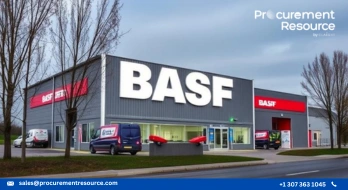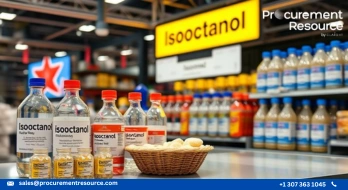India's Leading CPVC Resin and Epichlorohydrin Producer Reported a 23% Decline in Net Profit
.webp)
Meghmani Finechem Limited (MFL), a renowned chemical manufacturer situated in Gujarat, commissioned India's largest Chlorinated Polyvinyl Chloride Resin (CPVC) factory on Monday at the Dahej Petroleum, Chemicals and Petrochemicals Investment Region (PCPIR).
The new CPVC manufacturing unit, which is expected to cost Rs 190 crore, will have a capacity of 30,000 tonnes per annum (TPA), making it the sole factory of its kind in India. DCW Limited established the first 10,000 TPA factory in Tamil Nadu.
Request Access For the Latest Price Trends of Epichlorohydrin
According to Maulik Patel, Chairman, and Managing Director of MFL, the commissioning of the MFL plant will cut India's reliance on CPVC imports by almost 20 to 22%. Currently, imports account for 95% of CPVC Resin demand.
India's current demand for CPVC resin is estimated to be 1,40,000 TPA. The country's total production capacity would increase to 40,000 TPA with the commissioning of the MFL plant in Dahej. PVC pipe manufacturers like Finolex Industries, Astral Pipes, Supreme Industries, Ashirvad Pipes, Jain Irrigation, Prince Pipes & Fitting Ltd., and many others working in unorganised sectors primarily use CPVC, a special type of PVC with added chloride.
At Dahej PCPIR, where the business also operates five other chemical plants, including those for caustic soda, caustic potash, chloromethanes, hydrogen peroxide, and epichlorohydrin (ECH), the newly inaugurated CPVC factory has been placed strategically on a 60-hectare plot of ground.
They are also in the midst of establishing a Rs 180 crore Chlorotoluene production facility in Dahej PCPIR as part of our goal of becoming a multi-product specialty chemical firm', Patel said. Chlorotoluene is a unique chemical that is utilised as a solvent in the production of chemicals, medicines, synthetic rubber, and colours. It's also a bactericide and an insecticide.
The company intends to commission this plant, as well as a Research and Development Centre in Changodar, near Ahmedabad, in the fourth quarter of FY24," said MFL CMD. MFL's revenue increased to Rs 1,550.94 crore in 2021-22, up from Rs 831 crore in the previous fiscal year, due to increased chemical demand, particularly in the domestic market.
CPVC Price Trend
North America
CPVC prices fell throughout the quarter ending December 2022, owing to weak downstream demand from the building industry, a drop in the US real estate market, and a drop in the feedstock PVC Resin costs.
High inflation dampened buying demand in the local market, leading to a halt in regional industrial activity. Consumer scepticism has a significant impact on the CPVC business.
With significant stock availability, Formosa Plastics decided on a ten-day maintenance shutdown in Baton Rouge (USA) in December and November this quarter by lowering feedstock PVC capacity.
APAC
Prices for CPVC were cheap throughout the APAC region. The product price trend was influenced by weak downstream demand, growing input cost inflation, and low consumer trust in the construction industry.
The low market activity caused by the September Typhoons in several Asian nations, combined with Covid lockout measures, has impacted freight charges and overall feedstock PVC pricing.
Product prices fell as a result of need-based buying attitudes and slow economic conditions in the worldwide market. Meanwhile, CPVC maker DCW Ltd. announced plans to enhance commodity capacity in the Indian market by completing a new factory in FY24.
Europe
Due to adequate supply availability and sluggish downstream building demand in the region, CPVC prices have been trending downward in recent times. Meanwhile, volatility in crude oil prices and lower feedstock PVC prices have impacted the CPVC value chain in this quarter, amidst the European energy crisis and downstream market uncertainty.
Furthermore, pessimistic CPVC market sentiments in the regional market pushed market participants to limit profit margins in the region and destock piled-up stocks at lower prices.
The ease in feedstock PVC costs and fewer downstream construction sector inquiries in the European market remained the principal drivers driving the commodity's price decline.
Epichlorohydrin Price Trend
North America
The Epichlorohydrin market in North America, like the markets in Europe, has recently increased.
According to industry players, downstream textile and cosmetics companies are interested in the commodity for their manufacturing demands.
Additionally, the market for this product has declined for epoxy resin manufacturers. The product was scarce in warehouses and stocks due to fewer European imports and poor industrial activity in upstream industries due to moderate downstream demand. Nonetheless, the market was on the rise.
APAC
In recent times, the Epichlorohydrin market in Europe has grown significantly. Customers' fears about rising energy and natural gas prices as a result of the ongoing conflict between Russia and Ukraine, according to industry participants, were influencing demand.
Read More About Epichlorohydrin Production Cost Reports - Get Free Sample Copy in PDF
As a result, downstream epoxy resin manufacturers were less interested in this product. The product market in Germany arose as a result of the commodity's limited availability in warehouses and stockpiles as a result of upstream firms' average production operations. The same cause had a detrimental impact on exports.
Europe
The Asian market for Epichlorohydrin has recently been declining. Because textile and cosmetic manufacturing firms exhibited just a passing interest in it, adequate amounts of the product remained unsold in India, and suppliers were obliged to declare offers to raise their sales.
In China, the product market plummeted due to decreasing demand from downstream sectors, which were obliged to reduce production rates due to the re-implementation of Covid - 19 limits. Because of similar reasons, upstream firms were also pushed to cut the cost of epichlorohydrin production.
As per Procurement Resource, Meghmani Finechem Limited (MFL), a prominent Gujarat-based chemical producer, inaugurated India's largest Chlorinated Polyvinyl Chloride Resin (CPVC) factory on Monday at the Dahej Petroleum, Chemicals, and Petrochemicals Investment Region (PCPIR).
The new CPVC production unit, projected to cost Rs 190 crore, will have a capacity of 30,000 tonnes per annum (TPA), making it India's only factory of its sort. DCW Limited constructed Tamil Nadu's first 10,000 TPA factory.
The newly inaugurated CPVC factory is conveniently located on a 60-hectare parcel of land at Dahej PCPIR, where the company currently operates five other chemical plants, including those for caustic soda, caustic potash, chloromethanes, hydrogen peroxide, and epichlorohydrin (ECH).




.webp)